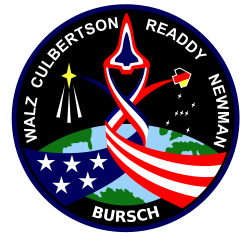James H. Newman
| James Hansen Newman | |
 | |
| NASA-Astronaut | |
|---|---|
| Född | 16 oktober 1956 |
| Tid i rymden | 43 dagar, 10 timmar, 7 minuter |
| Urvalsgrupp | Astronautgrupp 13 |
| Uppdrag | STS‑51, STS‑69, STS‑88, STS‑109 |
| Uppdragsemblem | |
James Hansen Newman, född 16 oktober 1956, är en amerikansk astronaut uttagen i astronautgrupp 13 den 17 januari 1990.
Rymdfärder
Källor
”Biographical Data” (på engelska) (PDF). NASA. augusti 2008. https://www.nasa.gov/wp-content/uploads/2016/01/newman_james.pdf?emrc=725609. Läst 24 november 2024.
Media som används på denna webbplats
Designed by the crew members, this patch commemorates the first assembly flight to carry United States-built hardware for constructing the International Space Station (ISS). This flight's primary task is to assemble the cornerstone of the Space Station: the Node with the Functional Cargo Block (fgb). The rising sun symbolizes the dawning of a new era of international cooperation in space and the beginning of a new program: the International Space Station. The Earth scene outlines the countries of the Station Partners: the United States, Russia, those of the European Space Agency (ESA), Japan, and Canada. Along with the Pressurized Mating Adapters (PMA) and the Functional Cargo Block, the Node is shown in the final mated configuration while berthed to the Space Shuttle during the STS-88/2A mission. The Big Dipper Constellation points the way to the North Star, a guiding light for pioneers and explorers for generations. In the words of the crew, "These stars symbolize the efforts of everyone, including all the countries involved in the design and construction of the International Space Station, guiding us into the future."
Emblem of Nasa's STS-109 mission.
Emblem of Nasa's STS-51 mission.
Astronaut James H. Newman
STS-69 Mission Insignia




